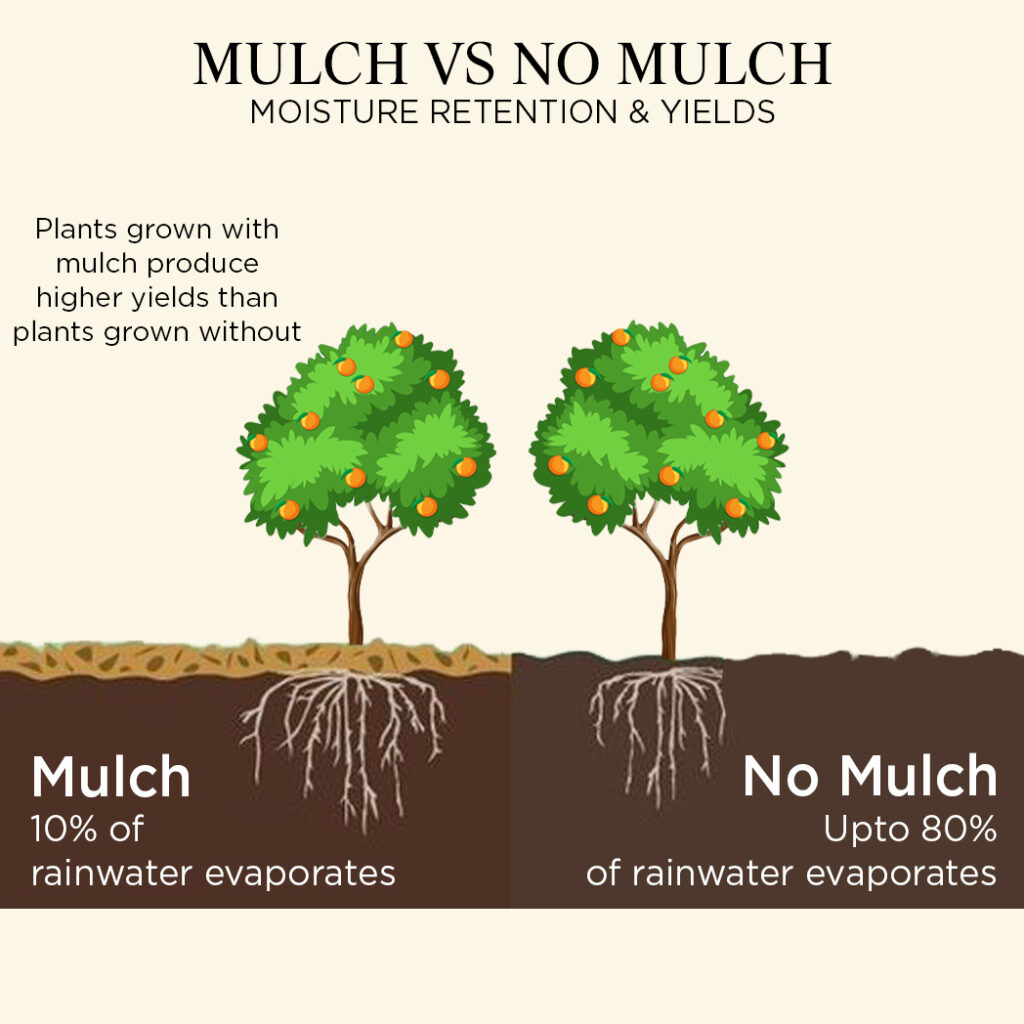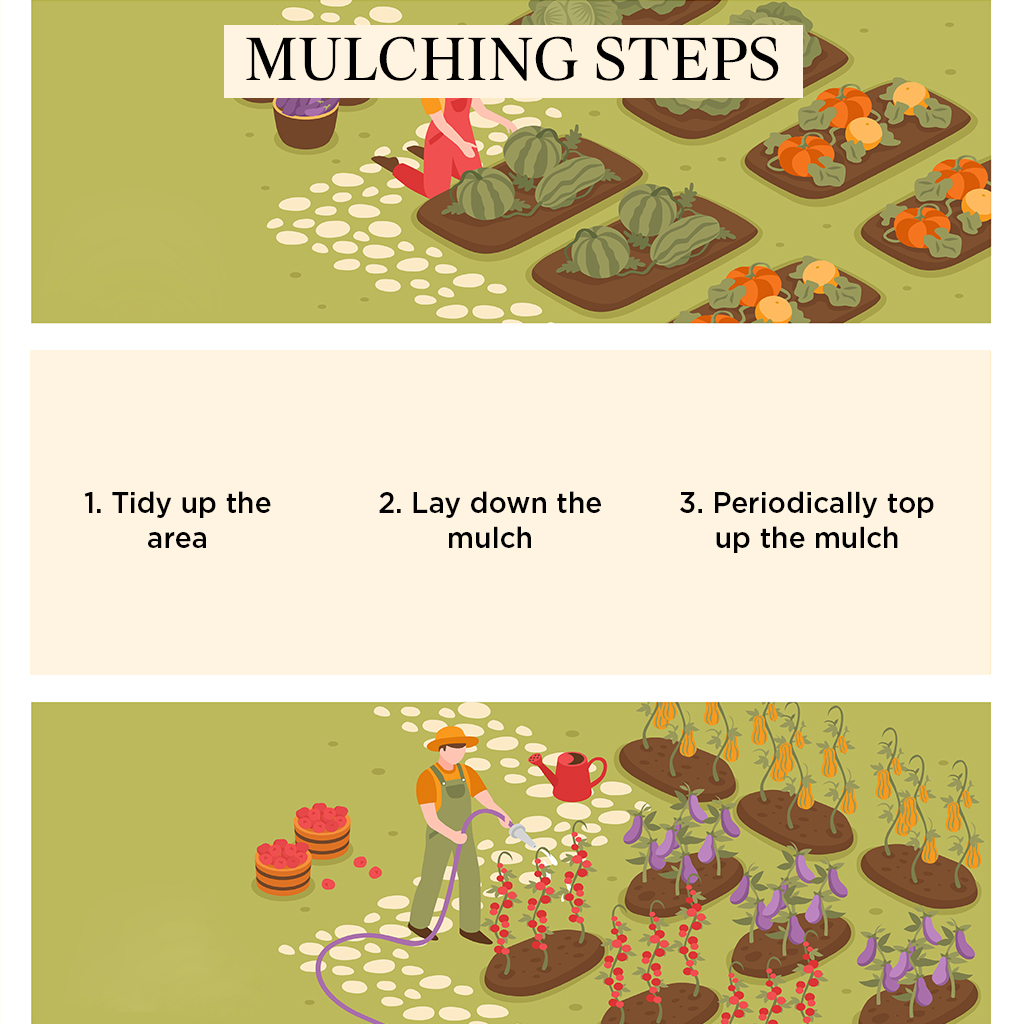
“Nature does have manure and she does have roots as well as blossoms, and you can’t hate the manure and blame the roots for not being blossoms.”
-R. Buckminster
-R. Buckminster
Lets envision your garden as a cozy home for your plants. Just as we use blankets to keep ourselves warm and snug during a chilly night, mulch does the same for your garden beds. It wraps your plants in comfort and offers a whole bunch of benefits too. Mulching is a widely practiced gardening technique that is beneficial for your garden. It is the act of covering the soil with mulches, such as bark, wood chips, leaves and other organic material. This helps to preserve moisture, improve the soil’s condition and block out the growth of weed.
Magic of Mulching
The magic of mulch unfolds in the following ways:
- Temperature Control: Mulch acts as insulation for your soil meaning it keeps the plants warm. It shields your plants’ roots from extreme temperatures, increasing comfort during times of scorching heat and freezing cold.
- Water Saver: Mulch is like a sponge that soaks up water and keeps it close to your plants’ roots. This means less water evaporates into the air and your plants stay hydrated even during stifling heat.
- Weed Blocker: Picture mulch as a barrier, blocking sunlight from reaching any of the weed seeds. By reducing the amount of sunlight your garden is exposed to, the less amount of weeds(can refer to Weeds chapter if needed) present.

Mulch, your garden’s blanket, is an important part of your garden, but that doesn’t mean it can’t be fashionable too. Just like picking out clothes to match the occasion, choosing the right mulch is key. As per the *Chicago Botanic Garden, there are different kinds including:
Organic Mulch: It is derived from natural materials such as bark, wood chips, straw, and compost, regulates soil temperature and retains moisture while simultaneously enriching the soil with valuable nutrients as it decomposes. This type of mulch promotes soil health and reduces the necessity for synthetic fertilisers.
Inorganic Mulch: It is made up of materials like gravel, stones, or plastic, excels in weed control and reflects sunlight, aiding in the cooling of plants. This low-maintenance, long-lasting solution is ideal for those prioritizing durability and simplicity in garden maintenance.
Living Mulch: Living mulch introduces ground covers like clover or creeping thyme, acting as a dynamic and living protective layer for the soil. Beyond reducing erosion, it enhances biodiversity in the garden, offering both sustainability and an environmentally friendly approach to landscaping.
Organic Mulch: It is derived from natural materials such as bark, wood chips, straw, and compost, regulates soil temperature and retains moisture while simultaneously enriching the soil with valuable nutrients as it decomposes. This type of mulch promotes soil health and reduces the necessity for synthetic fertilisers.
Inorganic Mulch: It is made up of materials like gravel, stones, or plastic, excels in weed control and reflects sunlight, aiding in the cooling of plants. This low-maintenance, long-lasting solution is ideal for those prioritizing durability and simplicity in garden maintenance.
Living Mulch: Living mulch introduces ground covers like clover or creeping thyme, acting as a dynamic and living protective layer for the soil. Beyond reducing erosion, it enhances biodiversity in the garden, offering both sustainability and an environmentally friendly approach to landscaping.

Adding mulch to your garden only serves its purpose when done right. In order to maximise effectiveness, one must follow these steps:
Clean the Area: Tidy up your garden bed by removing any weeds or debris
Spread the Mulch: Gently lay down the mulch around your plants, ensuring it is not too close to the stems, and spreading it out evenly
Top-Up Routine: Mulch over time tends to thin out. Therefore, it is vital that you periodically top it up to create the perfect environment for your plants.
Mulch is the comfy blanket that your garden needs – a multi-purpose layer that keeps your plants happy regardless of condition. With the right mulch, your plants will thrive, and your garden will be converted into a haven of comfort and beauty.
Clean the Area: Tidy up your garden bed by removing any weeds or debris
Spread the Mulch: Gently lay down the mulch around your plants, ensuring it is not too close to the stems, and spreading it out evenly
Top-Up Routine: Mulch over time tends to thin out. Therefore, it is vital that you periodically top it up to create the perfect environment for your plants.
Mulch is the comfy blanket that your garden needs – a multi-purpose layer that keeps your plants happy regardless of condition. With the right mulch, your plants will thrive, and your garden will be converted into a haven of comfort and beauty.
Useful Links
Categories
Newest Listings
Rethink and Revive@2024




